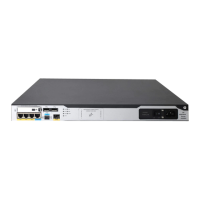51
• Typically, the receiver host receives the multicast data from Source 1 in the OSPF domain.
Configure the routers so that the receiver host can receive multicast data from Source 2, which is outside
the OSPF domain.
Figure 20 Network diagram
Configuration procedure
1. Assign an IP address and subnet mask for each interface according to Figure 20. (Details not
shown.)
2. Enable OSPF on Router B and Router C to make sure the following conditions are met: (Details not
shown.)
{ The routers are interoperable at the network layer.
{ The routers can dynamically update their routing information.
3. Enable IP multicast routing, and enable IGMP and PIM-DM:
# On Router C, enable IP multicast routing.
<RouterC> system-view
[RouterC] multicast routing
[RouterC-mrib] quit
# Enable IGMP on GigabitEthernet 2/1/1 (the interface that connects to the receiver host).
[RouterC] interface gigabitethernet 2/1/1
[RouterC-GigabitEthernet2/1/1] igmp enable
[RouterC-GigabitEthernet2/1/1] quit
# Enable PIM-DM on GigabitEthernet 2/1/2.
[RouterC] interface gigabitethernet 2/1/2
[RouterC-GigabitEthernet2/1/2] pim dm
[RouterC-GigabitEthernet2/1/2] quit
# On Router A, enable IP multicast routing, and enable PIM-DM on each interface.
<RouterA> system-view
[RouterA] multicast routing
[RouterA-mrib] quit
[RouterA] interface gigabitethernet 2/1/1
[RouterA-GigabitEthernet2/1/1] pim dm

